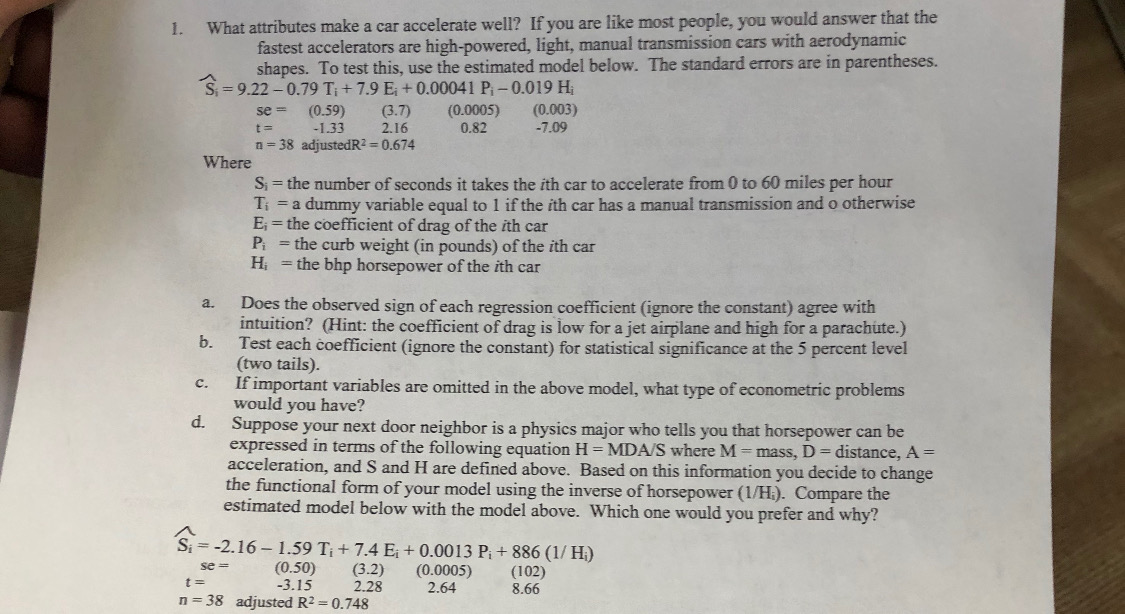ECONOMETRICS
1. What attributes make a car accelerate well? If you are like most people, you would answer that the fastest accelerators are high-powered, light, manual transmission cars with aerodynamic shapes. To test this, use the estimated model below. The standard errors are in parentheses. S = 9.22 -0.79 T;+ 7.9 E; +0.00041 P; -0.019 H se = (0.59) (3.7) (0.0005) (0.003) t= -1.33 2 .16 0.82 -7.09 a=38 adjusted R2 = 0.674 Where Si = the number of seconds it takes the ith car to accelerate from 0 to 60 miles per hour Ti = a dummy variable equal to 1 if the ith car has a manual transmission and o otherwise E;= the coefficient of drag of the ith car P = the curb weight (in pounds) of the ith car H = the bhp horsepower of the ith car a. b. c. Does the observed sign of each regression coefficient (ignore the constant) agree with intuition? (Hint: the coefficient of drag is low for a jet airplane and high for a parachute.) Test each coefficient (ignore the constant for statistical significance at the 5 percent level (two tails). If important variables are omitted in the above model, what type of econometric problems would you have? Suppose your next door neighbor is a physics major who tells you that horsepower can be expressed in terms of the following equation H=MDA/S where M=mass, D= distance, A= acceleration, and S and H are defined above. Based on this information you decide to change the functional form of your model using the inverse of horsepower (1/H). Compare the estimated model below with the model above. Which one would you prefer and why? S = -2.16 - 1.59 T: + 7.4 E; +0.0013 P: +886 (1/H) se = (0.50) (3.2) (0.0005) (102) t= -3.15 2.28 2.64 8.66 n = 38 adjusted R2 = 0.748 1. What attributes make a car accelerate well? If you are like most people, you would answer that the fastest accelerators are high-powered, light, manual transmission cars with aerodynamic shapes. To test this, use the estimated model below. The standard errors are in parentheses. S = 9.22 -0.79 T;+ 7.9 E; +0.00041 P; -0.019 H se = (0.59) (3.7) (0.0005) (0.003) t= -1.33 2 .16 0.82 -7.09 a=38 adjusted R2 = 0.674 Where Si = the number of seconds it takes the ith car to accelerate from 0 to 60 miles per hour Ti = a dummy variable equal to 1 if the ith car has a manual transmission and o otherwise E;= the coefficient of drag of the ith car P = the curb weight (in pounds) of the ith car H = the bhp horsepower of the ith car a. b. c. Does the observed sign of each regression coefficient (ignore the constant) agree with intuition? (Hint: the coefficient of drag is low for a jet airplane and high for a parachute.) Test each coefficient (ignore the constant for statistical significance at the 5 percent level (two tails). If important variables are omitted in the above model, what type of econometric problems would you have? Suppose your next door neighbor is a physics major who tells you that horsepower can be expressed in terms of the following equation H=MDA/S where M=mass, D= distance, A= acceleration, and S and H are defined above. Based on this information you decide to change the functional form of your model using the inverse of horsepower (1/H). Compare the estimated model below with the model above. Which one would you prefer and why? S = -2.16 - 1.59 T: + 7.4 E; +0.0013 P: +886 (1/H) se = (0.50) (3.2) (0.0005) (102) t= -3.15 2.28 2.64 8.66 n = 38 adjusted R2 = 0.748







